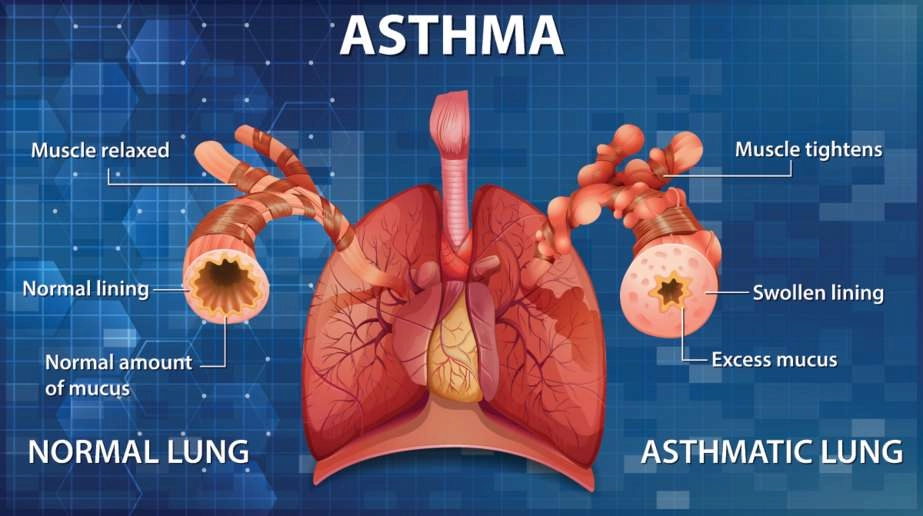Understanding Asthma Symptoms
Asthma manifests through a range of symptoms, including wheezing, shortness of breath, chest tightness, and coughing—often worse at night or during physical activity . Symptoms vary by type:
- Allergic asthmais triggered by pollen, dust mites, or pet dander.
- Exercise-induced asthmacauses breathing difficulties during or after exertion.
- Adult-onset asthmatypically develops due to environmental factors or comorbidities like obesity .
Untreated, asthma can lead to severe exacerbations requiring emergency care. Early diagnosis and tailored treatment are critical to preventing long-term lung damage.
Foundations of Asthma Management
Immediate Relief Medications
Short-acting bronchodilators like albuterol (via inhalers) provide rapid relief during attacks by relaxing airway muscles. These are essential for acute symptom control but do not address underlying inflammation .
Long-Term Control Therapies
- Inhaled corticosteroids (ICS): Reduce airway inflammation when used daily.
- Combination inhalers: Pair ICS with long-acting bronchodilators (e.g., fluticasone/salmeterol) for sustained symptom management.
- Biologics: Target specific immune pathways to block inflammation. For example:
- Omalizumab(Xolair) neutralizes IgE antibodies, effective for allergy-driven asthma .
- Benralizumab(Fasenra) reduces eosinophils, a key driver of severe asthma .
2025’s Cutting-Edge Treatments
Biologics Redefining Severe Asthma Care
Recent approvals and expanded indications for biologics have transformed outcomes for patients with severe asthma:
- Tezepelumab (Tezspire): The first biologic approved without biomarker restrictions, targeting TSLP to halt inflammation at its source. It reduces exacerbations by 50–70% in broad populations, including those with non-eosinophilic asthma .
- Dupilumab (Dupixent): Originally for eczema, this IL-4/IL-13 inhibitor now treats moderate-to-severe eosinophilic asthma. Real-world data show 58% of patients achieve remission within two years, with sustained improvements in lung function and quality of life .
- Benralizumab’s Emergency Use: A groundbreaking 2024 study demonstrated that a single benralizumab injection during acute exacerbations reduces hospitalizations more effectively than oral steroids, marking the first new emergency treatment in 50 years .
Smart Inhalers and Digital Health Integration
The global smart inhaler market is projected to reach $76 billion by 2034, driven by innovations like:
- Real-time monitoring: Devices track medication adherence, usage patterns, and environmental triggers (e.g., pollen levels) via smartphone apps .
- Predictive alerts: AI algorithms analyze data to forecast exacerbations, prompting proactive adjustments to treatment .
- Telehealth integration: Healthcare providers remotely monitor patients’ lung function and adjust therapies, improving access to care in underserved regions .
Personalized Medicine Paradigm
The AIM4 trial (2025), evaluating dupilumab vs. high-dose ICS in uncontrolled asthma, aims to validate early biologic intervention as a superior alternative to traditional stepwise escalation . GINA 2025 guidelines emphasize phenotype-driven care, recommending biomarker testing (e.g., eosinophils, FeNO) to tailor treatments and reduce reliance on high-dose steroids .
Lifestyle Strategies for Daily Management
Environmental Control
- Allergen reduction: Use HEPA filters, encase mattresses in dust mite-proof covers, and avoid smoking .
- Air quality awareness: Monitor pollution levels and stay indoors during peak periods, especially in urban areas .
Breathing Techniques and Exercise
- Pursed-lip breathingand diaphragmatic breathing improve airflow and reduce anxiety during attacks .
- Supervised exercise: Swimming, yoga, or low-impact activities enhance lung capacity when paired with pre-activity bronchodilators .
Diet and Stress Management
A diet rich in antioxidants (e.g., leafy greens, berries) and omega-3 fatty acids (fish, nuts) may reduce airway inflammation. Mindfulness practices and stress-reducing activities like meditation also help minimize asthma triggers .
Emergency Preparedness
Every patient should have a written asthma action plan, outlining medication schedules, trigger avoidance strategies, and steps for escalating care during worsening symptoms . Regularly share this plan with caregivers and update it with healthcare providers.
The Future of Asthma Care
2025’s advancements highlight a shift toward precision medicine, where treatments are tailored to individual biology rather than one-size-fits-all approaches. With biologics targeting inflammation at its roots, smart devices enabling proactive management, and global initiatives like GINA’s “Make Inhaled Treatments Accessible for All” , the goal of asthma control—if not cure—is closer than ever. By combining medical innovation with lifestyle adjustments, patients can now envision a future where asthma no longer limits their potential.a

